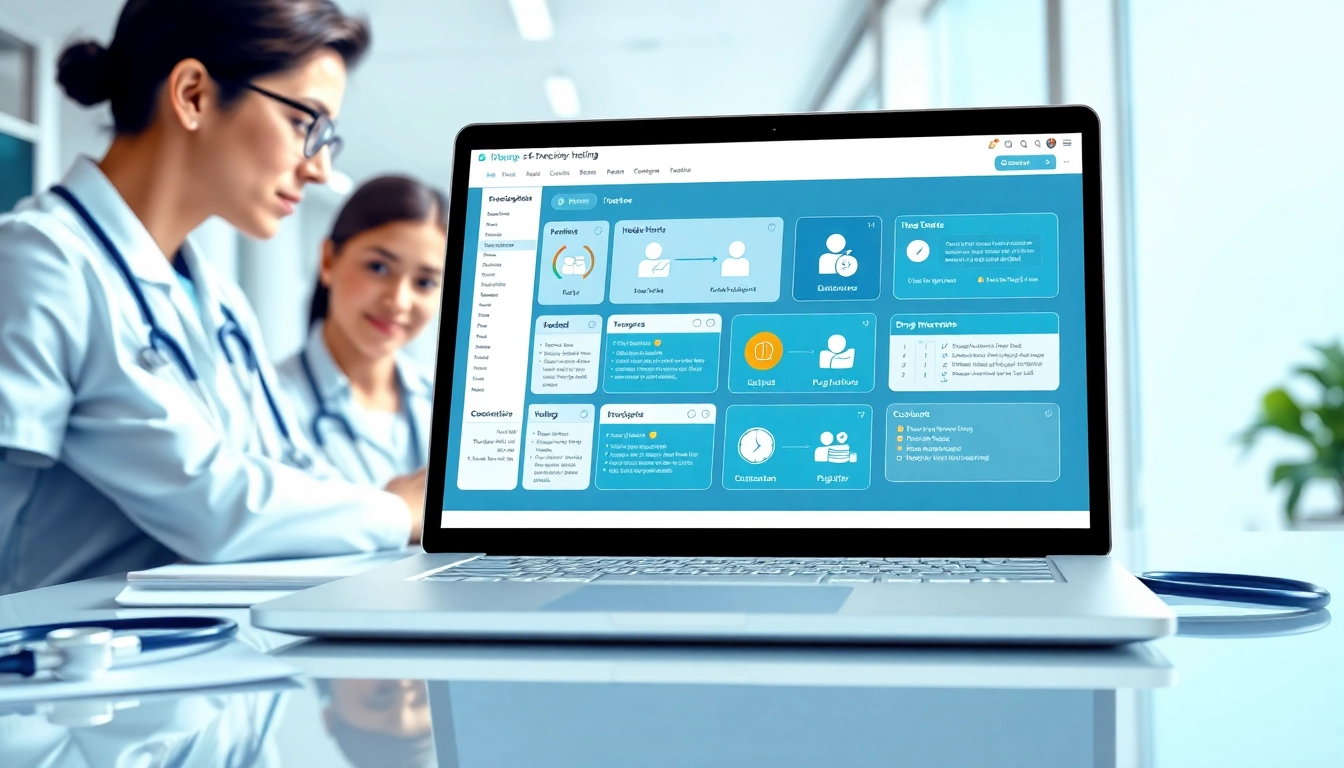The Importance of Eprescribing Software
In today’s fast-paced healthcare industry, efficiency and accuracy are paramount. With increasing patient volumes and rising demands for quality care, healthcare providers are turning to technology solutions that minimize error and streamline processes. One such solution is e-prescribing software, a digital tool that allows healthcare professionals to write and send prescriptions electronically. Using features of eprescribing software, providers can enhance their workflow significantly, ensuring that prescriptions are communicated quickly and accurately to pharmacies. This innovation is not just a convenience; it fundamentally transforms the prescribing process and improves patient outcomes. In this article, we will explore the critical aspects and benefits of e-prescribing software, highlighting its key features, usability, implementation best practices, and future trends.
Understanding Eprescribing Software
Eprescribing software constitutes a digital platform that enables healthcare providers to create and transmit prescriptions electronically. The transition from paper-based prescriptions to e-prescriptions has been transformative, aiming to reduce errors related to handwriting, misunderstandings, and prescription mismanagement. This shift not only enhances the accuracy of prescriptions but also integrates seamlessly with electronic health records (EHR) and pharmacy management systems.
Healthcare professionals can quickly access patient medication histories and allergies, making informed decisions about prescriptions. Well-designed e-prescribing solutions often include features that facilitate direct medication order to pharmacies, allowing for quicker patient access to medications and reduced wait times.
Key Benefits for Healthcare Providers
Utilizing e-prescribing software comes with a plethora of benefits for healthcare providers. Key advantages include:
- Efficiency: e-Prescribing eliminates the need for paper prescriptions, streamlining the prescribing process. Providers can prepare and send prescriptions in a matter of seconds.
- Enhanced Safety: The risk of medication errors decreases significantly as e-prescribing reduces misinterpretations associated with handwritten scripts.
- Improved Compliance: Many e-prescribing systems can alert providers about formularies, ensuring that prescriptions align with insurance coverage, thereby reducing patient costs.
- Increased Transparency: Providers can track prescription fulfillment, refills, and patient adherence over time, allowing for better healthcare management.
Impact on Patient Safety and Medication Errors
Patient safety remains a primary focus in healthcare, and e-prescribing plays a crucial role in minimizing medication errors. Traditional paper prescriptions can be poorly written or misinterpreted, leading to potentially harmful consequences. According to various studies, the adoption of e-prescribing has demonstrated a significant decrease in medication errors, contributing to safer medication practices.
Implementing features such as drug interaction alerts and allergy checks enhances patient safety even further. Providers receive real-time feedback regarding potential issues before prescriptions are sent, allowing them to make informed decisions that prioritize patient health.
Main Features of Eprescribing Software
Electronic Transmission of Prescriptions
One of the fundamental features of e-prescribing software is the electronic transmission of prescriptions to pharmacies. This process eliminates the delays associated with paper prescriptions, ensuring that prescriptions are received by the pharmacy concurrently with their creation. Providers can send prescriptions directly from their EHR systems, ensuring accuracy and timeliness while minimizing the risk of loss associated with paper documents. Moreover, this feature supports the secure and compliant exchange of sensitive patient information.
Real-Time Medication History Access
Access to real-time medication history offers providers comprehensive insights directly from patient records. This feature allows healthcare professionals to review prior prescriptions easily, aiding informed decision-making regarding new medications. Integrating medication history helps in identifying any previously dispensed drugs, detecting possible drug interactions, and ensuring that repeated prescriptions are appropriate, ultimately facilitating better patient care.
Drug Interaction Alerts and Safety Checks
Safety is paramount in prescribing medication. E-prescribing software is equipped with advanced algorithms to analyze prescriptions against a patient’s medical history, allergies, and current medications.
These systems automatically generate alerts when a potential drug interaction is identified, enabling providers to reconsider or discuss alternative treatments that safeguard the patient’s well-being. This feature greatly enhances the safety profile of prescribing practices and reinforces the responsible use of medications.
User Interface and Usability
Design and Navigation Considerations
The user interface of e-prescribing software greatly influences its adoption and overall user satisfaction. A well-structured layout, intuitive navigation, and responsive design are crucial to enhancing user experience. The use of clear menus, logical workflows, and easily accessible information reduces the cognitive load on healthcare providers, allowing them to focus on their patients rather than struggling with technology.
Customizable User Dashboards
Customizability is a significant advantage for healthcare providers using e-prescribing software. Customizable dashboards allow users to prioritize important information and streamline their workflows. Whether it’s recent patient histories, alerts, or pending prescriptions, personalized dashboards enable providers to work efficiently and access critical information quickly, thus enhancing their productivity.
Importance of Training and Support
Implementing e-prescribing software successfully involves thorough training and ongoing support for healthcare teams. Ensuring that users comprehend the functionalities and best practices of the software is vital for maximizing its potential benefits. Engaging in comprehensive training sessions, along with providing access to help resources and user manuals, empowers users to navigate the software confidently. Consistent support also allows for addressing any challenges that may arise post-implementation.
Best Practices for Implementing Eprescribing Software
Integration with Existing Systems
Successful e-prescribing software implementation requires seamless integration with existing healthcare systems, such as EHRs and billing platforms. Ensuring that the software can communicate efficiently with current infrastructure eliminates data silos and enhances workflow continuity. Providers should prioritize solutions that offer interoperability features, allowing for cohesive data sharing across systems while adhering to the required regulations regarding electronic health information.
Steps for Successful Adoption
Adopting e-prescribing software involves several key steps, including:
- Assessing Needs: Understand the specific needs and workflows of your healthcare facility before selecting a solution.
- Choosing a Solution: Evaluate various vendors and their offerings to find a system that best fits your requirements.
- Training Staff: Provide adequate training for all users to facilitate a smooth transition and integration into existing workflows.
- Monitoring Usage: After implementation, regularly monitor usage metrics to identify areas of improvement.
Monitoring and Continuous Improvement
Once e-prescribing software has been implemented, continuous monitoring and improvement are essential to ensure effective adoption and maintain high-quality care. Collecting feedback from users can highlight pain points and areas needing enhancement, allowing for ongoing system refinements. Furthermore, tracking performance metrics will enable healthcare providers to adapt their processes, align with best practices, and strive for greater efficacy in patient care.
Future Trends in Eprescribing Software
Emerging Technologies and Innovations
The future of e-prescribing is poised for significant innovation, integrating cutting-edge technologies such as artificial intelligence (AI) and machine learning (ML). These technologies can enhance predictive analytics significantly, allowing for dynamic adjustments to prescribing protocols based on patient data and treatment outcomes. AI-driven systems may facilitate more personalized medicine approaches, aligning prescriptions more closely with individual patient needs and improving adherence rates.
Patient Engagement and Mobile Access
As patient engagement increasingly becomes essential in healthcare, e-prescribing systems are adapting to involve patients in their own care. Mobile applications that allow patients to view, manage, and request refills for their prescriptions are gaining popularity. Enhanced patient access promotes engagement and fosters a more collaborative approach between healthcare providers and patients.
Regulatory Changes and Their Implications
As e-prescribing technology evolves, so too do the regulatory frameworks that govern it. Compliance with new regulations regarding patient data security, prescription forms, and payer requirements will shape how e-prescribing software is developed and utilized. Healthcare providers must remain vigilant and proactive in adapting to these changes, ensuring both compliance and the highest levels of patient care.



